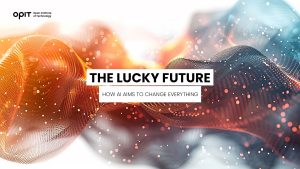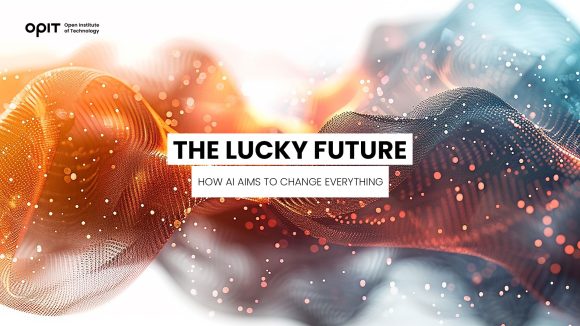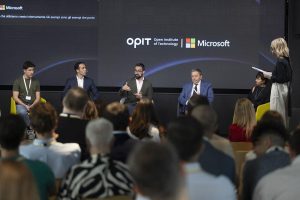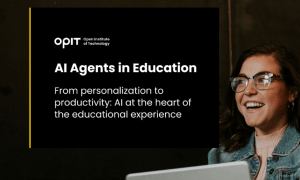

There is no question that the spread of artificial intelligence (AI) is having a profound impact on nearly every aspect of our lives.
But is an AI-powered future one to be feared, or does AI offer the promise of a “lucky future.”
That “lucky future” prediction comes from Zorina Alliata, principal AI Strategist at Amazon and AI faculty member at Georgetown University and the Open Institute of Technology (OPIT), in her recent webinar “The Lucky Future: How AI Aims to Change Everything” (February 18, 2025).
However, according to Alliata, such a future depends on how the technology develops and whether strategies can be implemented to mitigate the risks.
How AI Aims to Change Everything
For many people, AI is already changing the way they work. However, more broadly, AI has profoundly impacted how we consume information.
From the curation of a social media feed and the summary answer to a search query from Gemini at the top of your Google results page to the AI-powered chatbot that resolves your customer service issues, AI has quickly and quietly infiltrated nearly every aspect of our lives in the past few years.
While there have been significant concerns recently about the possibly negative impact of AI, Alliata’s “lucky future” prediction takes these fears into account. As she detailed in her webinar, a future with AI will have to take into consideration:
- Where we are currently with AI and future trajectories
- The impact AI is having on the job landscape
- Sustainability concerns and ethical dilemmas
- The fundamental risks associated with current AI technology
According to Alliata, by addressing these risks, we can craft a future in which AI helps individuals better align their needs with potential opportunities and limitations of the new technology.
Industry Applications of AI
While AI has been in development for decades, Alliata describes a period known as the “AI winter” during which educators like herself studied AI technology, but hadn’t arrived at a point of practical applications. Contributing to this period of uncertainty were concerns over how to make AI profitable as well.
That all changed about 10-15 years ago when machine learning (ML) improved significantly. This development led to a surge in the creation of business applications for AI. Beginning with automation and robotics for repetitive tasks, the technology progressed to data analysis – taking a deep dive into data and finding not only new information but new opportunities as well.
This further developed into generative AI capable of completing creative tasks. Generative AI now produces around one billion words per day, compared to the one trillion produced by humans.
We are now at the stage where AI can complete complex tasks involving multiple steps. In her webinar, Alliata gave the example of a team creating storyboards and user pathways for a new app they wanted to develop. Using photos and rough images, they were able to use AI to generate the code for the app, saving hundreds of hours of manpower.
The next step in AI evolution is Artificial General Intelligence (AGI), an extremely autonomous level of AI that can replicate or in some cases exceed human intelligence. While the benefits of such technology may readily be obvious to some, the industry itself is divided as to not only whether this form of AI is close at hand or simply unachievable with current tools and technology, but also whether it should be developed at all.
This unpredictability, according to Alliata, represents both the excitement and the concerns about AI.
The AI Revolution and the Job Market
According to Alliata, the job market is the next area where the AI revolution can profoundly impact our lives.
To date, the AI revolution has not resulted in widespread layoffs as initially feared. Instead of making employees redundant, many jobs have evolved to allow them to work alongside AI. In fact, AI has also created new jobs such as AI prompt writer.
However, the prediction is that as AI becomes more sophisticated, it will need less human support, resulting in a greater job churn. Alliata shared statistics from various studies predicting as many as 27% of all jobs being at high risk of becoming redundant from AI and 40% of working hours being impacted by language learning models (LLMs) like Chat GPT.
Furthermore, AI may impact some roles and industries more than others. For example, one study suggests that in high-income countries, 8.5% of jobs held by women were likely to be impacted by potential automation, compared to just 3.9% of jobs held by men.
Is AI Sustainable?
While Alliata shared the many ways in which AI can potentially save businesses time and money, she also highlighted that it is an expensive technology in terms of sustainability.
Conducting AI training and processing puts a heavy strain on central processing units (CPUs), requiring a great deal of energy. According to estimates, Chat GPT 3 alone uses as much electricity per day as 121 U.S. households in an entire year. Gartner predicts that by 2030, AI could consume 3.5% of the world’s electricity.
To reduce the energy requirements, Alliata highlighted potential paths forward in terms of hardware optimization, such as more energy-efficient chips, greater use of renewable energy sources, and algorithm optimization. For example, models that can be applied to a variety of uses based on prompt engineering and parameter-efficient tuning are more energy-efficient than training models from scratch.
Risks of Using Generative AI
While Alliata is clearly an advocate for the benefits of AI, she also highlighted the risks associated with using generative AI, particularly LLMs.
- Uncertainty – While we rely on AI for answers, we aren’t always sure that the answers provided are accurate.
- Hallucinations – Technology designed to answer questions can make up facts when it does not know the answer.
- Copyright – The training of LLMs often uses copyrighted data for training without permission from the creator.
- Bias – Biased data often trains LLMs, and that bias becomes part of the LLM’s programming and production.
- Vulnerability – Users can bypass the original functionality of an LLM and use it for a different purpose.
- Ethical Risks – AI applications pose significant ethical risks, including the creation of deepfakes, the erosion of human creativity, and the aforementioned risks of unemployment.
Mitigating these risks relies on pillars of responsibility for using AI, including value alignment of the application, accountability, transparency, and explainability.
The last one, according to Alliata, is vital on a human level. Imagine you work for a bank using AI to assess loan applications. If a loan is denied, the explanation you give to the customer can’t simply be “Because the AI said so.” There needs to be firm and explainable data behind the reasoning.
OPIT’s Masters in Responsible Artificial Intelligence explores the risks and responsibilities inherent in AI, as well as others.
A Lucky Future
Despite the potential risks, Alliata concludes that AI presents even more opportunities and solutions in the future.
Information overload and decision fatigue are major challenges today. Imagine you want to buy a new car. You have a dozen features you desire, alongside hundreds of options, as well as thousands of websites containing the relevant information. AI can help you cut through the noise and narrow the information down to what you need based on your specific requirements.
Alliata also shared how AI is changing healthcare, allowing patients to understand their health data, make informed choices, and find healthcare professionals who meet their needs.
It is this functionality that can lead to the “lucky future.” Personalized guidance based on an analysis of vast amounts of data means that each person is more likely to make the right decision with the right information at the right time.
Related posts

Source:
- Times of Malta, published on September 18th, 2025
4 min read
The gathering brought together academics and technology leaders from prominent European Institutions, such as Instituto de Empresa (IE University), OPIT itself and the Royal College of Arts, to explore how artificial intelligence is reshaping the university experience.
The OPIT AI Copilot has been trained on the institute’s complete academic archive, a collection created over the past three years that includes 131 courses, more than 3,500 hours of recorded lectures, 7,500 study resources, 320 certified assessments, and thousands of exercises and original learning documents.
Unlike generic AI tools, the Copilot is deeply integrated with OPIT’s learning management system, allowing it to track each student’s progress and provide tailored support.
This integration means the assistant can reference relevant sources within the learning environment, adapt to the student’s stage of study, and ensure that unreleased course content remains inaccessible.
A mobile app is also scheduled for release this autumn, that will allow students to download exercise and access other tools.
During examinations, the Copilot automatically switches to what the institute calls an “anti-cheating mode”, restricting itself to general research support rather than providing direct answers.
For OPIT’s international community of 500 students from nearly 100 countries, many of whom balance studies with full-time work, the ability to access personalised assistance at any time of day is a key advantage.
“Eighty-five per cent of students are already using large language models in some way to study,” said OPIT founder and director Riccardo Ocleppo. “We wanted to go further by creating a solution tailored to our own community, reflecting the real experiences of remote learners and working professionals.”
Tool aims to cut correction time by 30%
The Copilot will also reduce administrative burdens for faculty. It can help grade assignments, generate new educational materials, and create rubrics that allow teachers to cut correction time by as much as 30 per cent.
According to OPIT, this will free up staff to dedicate more time to teaching and direct student engagement.
At the Milan event, Rector Francesco Profumo underlined the broader implications of AI in higher education. “We are in the midst of a deep transformation, where AI is no longer just a tool: it is an environment that radically changes how we learn, teach, and create,” he said.
“But it is not a shortcut. It is a cultural, ethical, and pedagogical challenge, and to meet it we must have the courage to rethink traditional models and build bridges between human and artificial intelligence.”
OPIT was joined on stage by representatives from other leading institutions, including Danielle Barrios O’Neill of the Royal College of Art, who spoke about the role of AI in art and creativity, and Francisco Machin of IE University, who discussed applications in business and management education.
OPIT student Asya Mantovani, also employed at a leading technology and consulting firm in Italy, gave a first-hand account of balancing professional life with online study.
The assistant has been in development for the past eight months, involving a team of OPIT professors, researchers, and engineers.
Ocleppo stressed that OPIT intends to make its AI innovations available beyond its own institution. “We want to put technology at the service of higher education,” he said.
“Our goal is to develop solutions not only for our own students, but also to share with global institutions eager to innovate the learning experience in a future that is approaching very quickly.”

From personalization to productivity: AI at the heart of the educational experience.
Click this link to read and download the e-book.
At its core, teaching is a simple endeavour. The experienced and learned pass on their knowledge and wisdom to new generations. Nothing has changed in that regard. What has changed is how new technologies emerge to facilitate that passing on of knowledge. The printing press, computers, the internet – all have transformed how educators teach and how students learn.
Artificial intelligence (AI) is the next game-changer in the educational space.
Specifically, AI agents have emerged as tools that utilize all of AI’s core strengths, such as data gathering and analysis, pattern identification, and information condensing. Those strengths have been refined, first into simple chatbots capable of providing answers, and now into agents capable of adapting how they learn and adjusting to the environment in which they’re placed. This adaptability, in particular, makes AI agents vital in the educational realm.
The reasons why are simple. AI agents can collect, analyse, and condense massive amounts of educational material across multiple subject areas. More importantly, they can deliver that information to students while observing how the students engage with the material presented. Those observations open the door for tweaks. An AI agent learns alongside their student. Only, the agent’s learning focuses on how it can adapt its delivery to account for a student’s strengths, weaknesses, interests, and existing knowledge.
Think of an AI agent like having a tutor – one who eschews set lesson plans in favour of an adaptive approach designed and tweaked constantly for each specific student.
In this eBook, the Open Institute of Technology (OPIT) will take you on a journey through the world of AI agents as they pertain to education. You will learn what these agents are, how they work, and what they’re capable of achieving in the educational sector. We also explore best practices and key approaches, focusing on how educators can use AI agents to the benefit of their students. Finally, we will discuss other AI tools that both complement and enhance an AI agent’s capabilities, ensuring you deliver the best possible educational experience to your students.
Have questions?
Visit our FAQ page or get in touch with us!
Write us at +39 335 576 0263
Get in touch at hello@opit.com
Talk to one of our Study Advisors
We are international
We can speak in:
